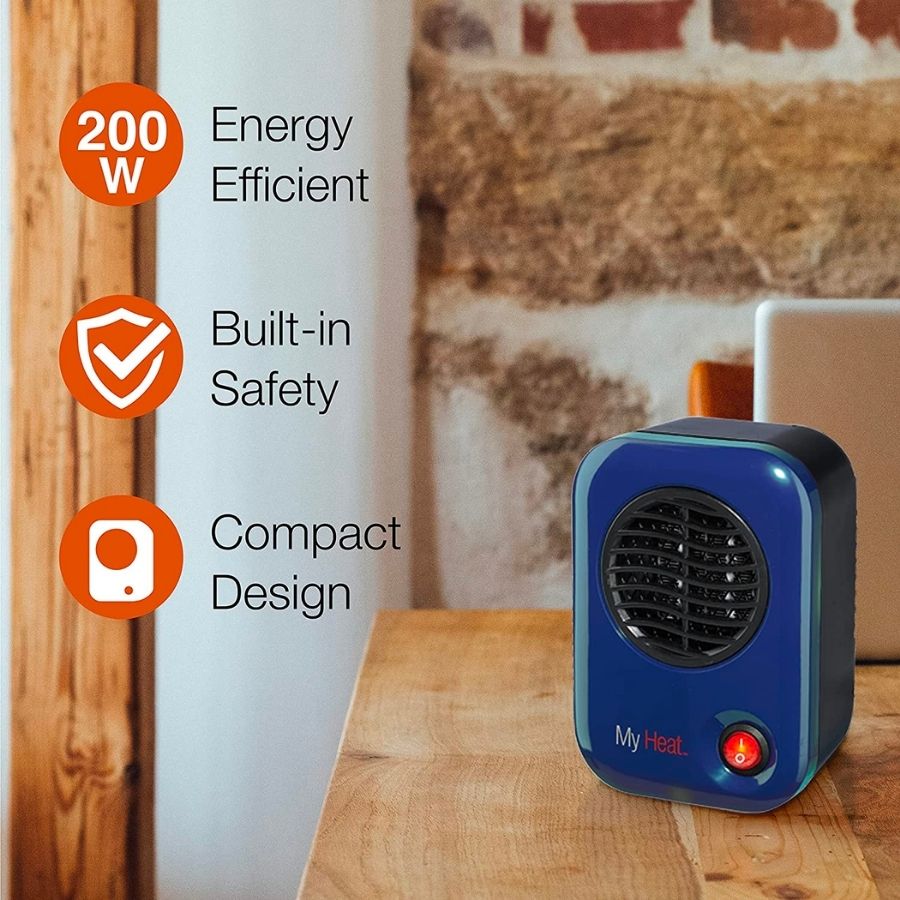If you are camping off the grid and are looking for a battery-powered heater for a camping tent that you can just turn on, well, you are almost at the right place.
When it comes to a portable heater for camping tents, our options are quite limited. The problem here is not the companies that make camping gear, but it’s “Physics” really.
Turns out, storing energy is quite difficult and inefficient with batteries, so they are not the most efficient source of heating up your large tent space.
Although you will find battery-operated heaters in the market, and they do work, they are not as effective as plug-in heaters or gas-powered heaters.
With this disclaimer out of the way, let’s see some battery-powered heaters for camping tents.
Battery-operated heater for camping
First of all, do note that any battery-operated heater for your tent will not be heavy-duty.
Most of the camping heaters we will discuss below will have a power rating of 150 watts to 300 watts and work with a 12v power source. These 12v heaters for camping plug directly into your portable camping battery.
So, along with the heater, we also need to find a suitable camping battery that is portable yet stores enough power to heat up our tent space. You will find a list of suitable batteries in this article as well.
Let’s first look at some battery-operated heaters for camping tents.
120v / 12v battery-powered tent heaters
If you have been using electric space heaters at home, do remember that these small tent heaters are not exactly like them.
Since you are going to operate them on a battery bank, they are quite underpowered, and some of them are even designed as car heaters and defoggers.
On your battery bank, you will have outlets for both 12v and 120v so you can use either type of heater.
Your regular electric space heater has a power rating of 1500W to 2000W. Compared to them, these portable electric heaters are only 150W – 300W.
So, if they don’t perform as well as your regular space heater, don’t be disappointed.
Lasko Heating Space Heater
Our first battery-operated heater option for camping is from Lasko.
It’s similar to the Honeywell model that I prevoiusly had here (been discontinued) but with a slightly lower 200 watts rating.
The lower rating allows for a bit longer use on the same battery but will have slightly less heat output as well.

When you plug this into the Yeti 1500X battery bank, it can last for 7.5 hours.
Since it’s a low-rated filament heater, the heat will be just enough to keep you from freezing but won’t give you a fully heated tent.
If your tent is small, you might be able to keep yourself warm all night long.
One neat trick that I have used many times is putting the heater under my blanket for 10-15 minutes to warm up the air bubbles inside the blanket stuffing.
It greatly helps when it’s too cold outside, and your body isn’t generating enough heat to warm up the bulky blanket. Make sure you do this very carefully to avoid any fire risk. These 200W small heaters are perfect for this hack.
Check Lesko space heater on Amazon for the latest prices, availability, and user reviews.
Kimviento Mini-Space Heater
Our next battery-operated heater option for camping is from Kimviento.
This mini-space heater is a 200W personal space heater originally designed to heat up your office desk, but it can work well within your small tent when connected to your power bank’s AC adaptor.
The heater features easy-to-use design, tip-over switch, cool-touch housing, and overheat protection.

If you have a small one-person tent that is well insulated, this heater is enough to keep you warm for a good few hours on a battery power station.
If you use this with the Yeti 1500X portable power station (details below), it can last as long as 7.5 hours. Which is pretty sufficient for a night’s sleep.
But I would recommend turning it off before you sleep to make sure it doesn’t create a fire hazard.
Check out its availability, user reviews, and latest price on Amazon.
Back Seat Heat Plus
This one is slightly different from the previous two heaters we listed. The Back Seat Heat Plus is a 12v heater designed to heat up the backseat of your car or truck.
But with slight modifications in wiring, you can use it with your battery power station.

It is a 300 watts heater with impressive 1100BTU heat output.
When coupled with the Yeti 1500X battery bank, it can last up to 4 hours. If you keep the thermostat setting on low, it can last a few extra hours as well.
Again, this is a very small heater designed to heat up a closed cabin, so your tent must be small for one person to be effective.
Since this operates on 12v instead of 120v, you have to connect it to the battery’s 12v DC output pins. Since this will be drawing a high ampere current, ensure the wire clips are tightly closed, and there is no sparking or overheating at wires.
Check out the Back Seat Heat Plus on Amazon for the latest price, availability, and user feedback.
Portable battery for camping
Camping batteries are rechargeable power sources mainly designed as a power bank to top off your electronics while staying off-grid.
However, you can use the same battery to power your portable heater for camping.
If you are going to power your heater, you will need the biggest battery you can find to heat your tent for at least a few hours.
The good news is that these batteries can be easily charged using solar panels, even if you stay completely off-grid.
Here are a few batteries that are suitable for operating a 12v camping heater (they can also be used to power other things like battery-operated kettles or even small battery-operated air conditioners).
Keep in mind these are NOT cheap as batteries have always been expensive power storage devices.
Yeti 1500X Portable Power
This monster power bank has a total capacity of 1516Wh. It can charge all your devices and run your electric heater for a good few hours.
It has a standard 120W power supply that can charge it in 14 hours. You can also charge it in just 4 hours with 400W solar panels.
It’s a good option for total off-grid camping.
Jackery Explorer 1000
With 1002Wh capacity, this is the 2nd largest bank I have seen in the market that is still portable.
You can charge this via a standard power outlet and solar panels. The 2nd option is going to take a long time, but if you are out in the sunny wild, hook it up to your panels outside and get a fully charged battery in the evening.
BALDR Portable Power Station
You will store 461Wh with this battery pack which is not as high as the previous two but still pretty good.
Remember that with smaller batteries, you also get a smaller charging time, especially with solar panels.
If you don’t want to carry around huge rechargeable batteries, another way to power your portable heater is through camping generators.
Although the camping generators are quite noisy they do provide uninterrupted power that can run a high-wattage space heater for a long time.
Once you have sorted out your power source, it’s time to find a suitable battery-powered heater. Let’s see what our options are
How long will battery operated heater last?
This question is best answered if we know which battery are we going to use and which heater are we going to run.
To calculate the number of hours your battery will run a certain space heater, you will have to divide the capacity of your battery in Watt-hours by the power rating of your heater in Watts.
Heater run time (hours) = Battery Capacity (Wh) / Heater rating (W)
For the sake of example, the below table summarizes the run time of all three heaters we discussed above on each of the batteries.
Alternate portable heater for camping
If you are unhappy with your battery-powered heater you can go for a more traditional heating option. Below are a few portable heaters for camping that you can use.
| Heater/Battery | Yeti X500 | Jackery Explorer | BALDR |
|---|---|---|---|
| Lasko Heating | 7.8 hrs | 5.01 hrs | 2.3 hrs |
| Kimviento Mini | 7.5 hrs | 5 hrs | 2.1 hrs |
| Back Seat Heat Plus | 5.2 hrs | 3.34 hrs | 1.5 hrs |
Several different heating options can be used to keep a camping tent warm during the winter months.
Propane Heaters
One option is to use a propane heater, which burns propane gas to generate heat. Propane heaters are generally easy to use and are relatively safe as long as they are properly ventilated.
However, they can be expensive to operate, and some campers may be concerned about the environmental impact of burning fossil fuels.
Also, carrying propane tanks around is as bulky as carrying heavy portable battery banks. But compared to battery banks, propane cylinders are cheap (can also be refilled) and long a last time.
Firewood
Another option is to use firewood to heat the tent. This can be a good option if you are camping in an area where firewood is readily available and there is no fire ban.
If you have the necessary tools to start and maintain a fire safely, this is a good option. However, firewood can be messy and difficult to transport, and it may not be practical in some environments.
Fire also creates a lot of smoke that is not desirable inside the tent, so you have to make the fire just outside the tent or in the vestibule area and let the heat creep inside.
Heated stones
Heated stone mass, which is a large, heavy stone that has been heated in a fire and then placed inside the tent to radiate heat.
If you have a campfire, you can heat a large stone mass and carry it inside your tent. The stone will keep radiating heat well into the cold night before it gets cold.
This can be a good option if you have access to a source of heat and are able to transport and handle the heated stone safely.
Hot water bottles
Another option is to use hot water bottles to provide heat inside the tent. This is similar to the heated stone mass, but instead of the stone, we heat water.
However, hot water bottles will only provide a limited amount of heat as water is a poor energy storage medium. But since we already carry water on our camping trips, it is a good idea to use the available resources.
This is also a good idea to prevent your camping water bottles from freezing on cold winter nights.
Candle lanterns
Finally, candle lanterns can also be used to provide some heat inside a tent. However, candle lanterns are not very effective at heating a large space, and they can be dangerous if not used properly.
Overall, there are pros and cons to each of these heating options, and the best choice will depend on the specific situation and personal preferences of the camper.
I have written a comprehensive blog on how to heat your tent during winter camping that you can go through for details of the above options.
Happy and warm camping!
Recommended Camping Gears: I have compiled a list of my favourite camping gear in one place. The selection is based on my own personal experience using them for many years camping as well as feedback from fellow campers. Check them out on my Recommended Camping Gears page